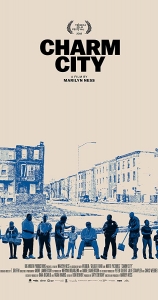
The ‘C’ in Charm flickers. The documentary title, Charm City, switches between Charm and Harm City, and then it begins. Scenes of the streets of Baltimore cascade across the screen: men smoking on a front stoop, a young girl peeking out her window, a police cars lights flashing in a dark alley. This is Baltimore.
Baltimore is known, throughout the country, as a crime ridden city. Its streets filled with needles, drugs, and murders.
It’s not until you get to know the city that you realize how much more this city really has to offer. Baltimore is filled with beautiful, old buildings, museums, waterfronts, universities, and much more that I have yet to explore. The rumors, however, do still ring true. Much of the city is still filled with violence, and inequality.
The documentary follows the efforts, of many different Baltimore natives, to lower the crime rate, keep their communities and families safe, and prove to everyone that their city is much more than just a murder rate reaching the top of the charts. The audience gets insight on one community member, and his entourages efforts in their neighborhood. Mr. C runs the Rose Street Community Center. He is the communities guide, wisdom filled master, and man with all the answers. He is respected and has many young men and women that look up to him, and see him as their leader. Through him, and Rose Street, there are several programs being run: a street cleanup crew, conflict mediation crew, and a youth group to keep the children active, and off the streets.
We then follow a police captain and her team, through a normal 12 hour day tolling the city for crime. However, we get a glimpse of the good as well, when we are shown scenes of one officer joining in on a game of cards, or stopping by to listen to a marching band practice. Those were the moments of hope, of true connection the producer gets through to the audience so seamlessly.
The last person showcased, who has made huge efforts to lower the crime rate, is Baltimore’s youngest councilman Brandon Scott. He initiates the discussion of making the city’s efforts interdisciplinary, so that the sole responsibility does not lay on the police forces shoulders, but instead is spread across public safety, and public health and even the school system.
Everyone’s efforts have already made a difference in decreasing the violence rate. The natives were so open, and willing to share the occurrences of their daily lives over a span of three years with the filming crew, and the filming crew so respectful about not intruding or intervening into their daily lives. This documentary will definitely make you want to get out there and make a difference, so, let’s do it!
BY AMELIA MEIER
